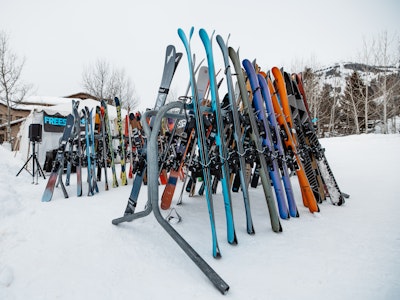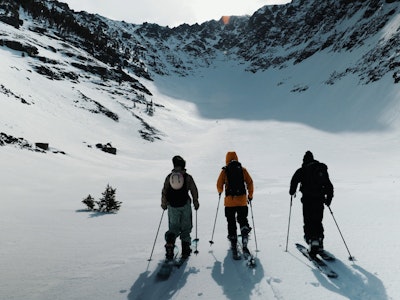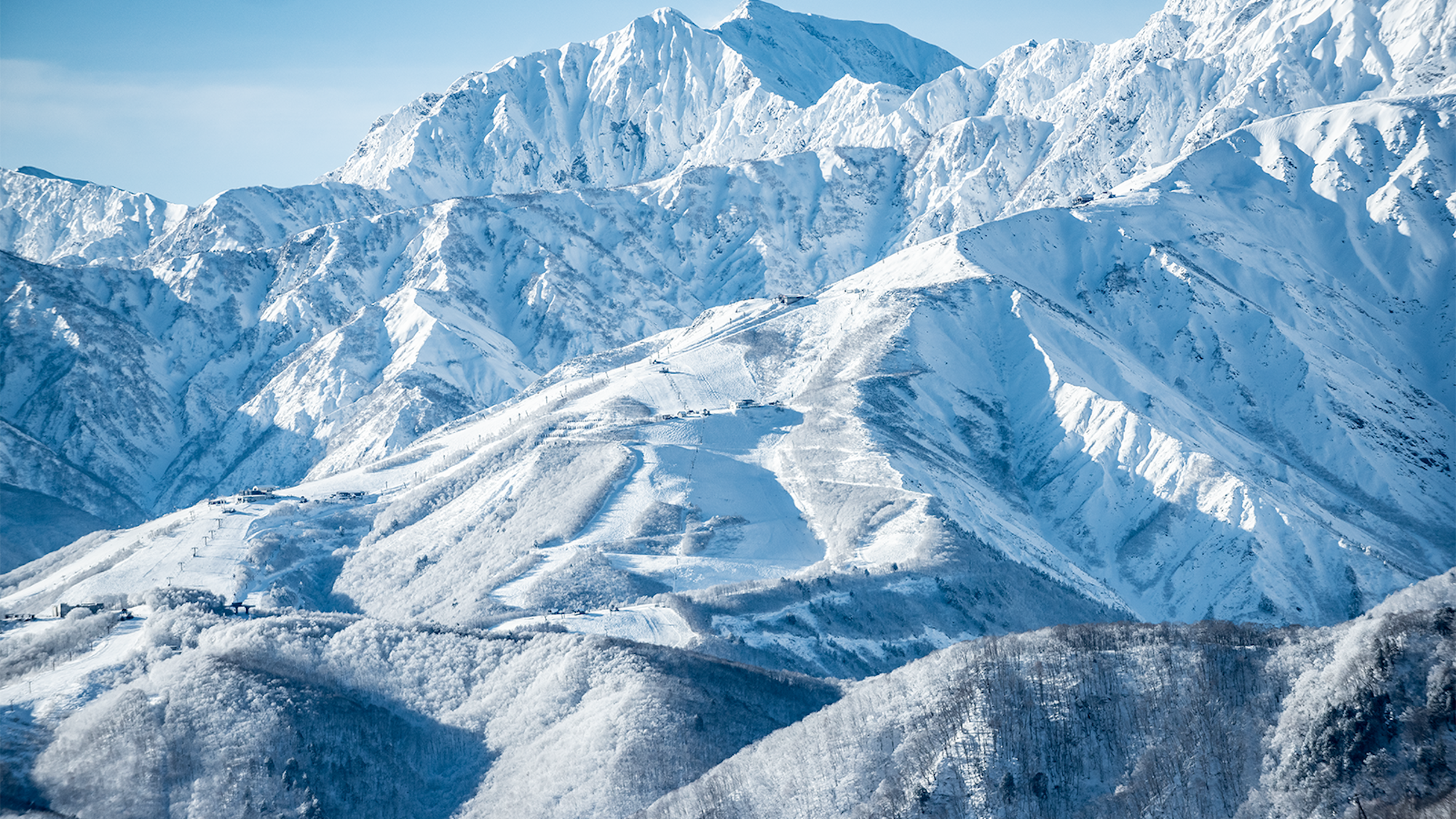Featured Image: Hiraya Nakata | Location: Hakuba, Japan
MY FIRST TURN off the ridge wasn’t very steep—a gentle, 25-degree pitch. Fat flakes were falling from above and the snow was stacking up at two inches per hour as I dropped in. I gained momentum as the gradient steepened, and the seemingly bottomless snow billowed up around my torso. I focused on surfing across the top; I didn’t want to dive too deep and risk pairing an extra-long face shot with an accidental encounter with one of the perfectly spaced trees I was skiing among. I made a dozen dreamy powder smears before pulling off behind a tree to wait for my partner.
It was our first day of the trip, and we both agreed on a conservative approach while we gained our bearings in the new terrain. As I radioed up to him, I felt a faint, prickly sensation on the back of my neck—the strange sensation you get when you feel like you’re being watched. My partner dropped in, playfully porpoising his way toward me through the freeze-dried ocean, and let out a stoke-filled yelp. Just then, I heard a light rustling in the branches behind me.
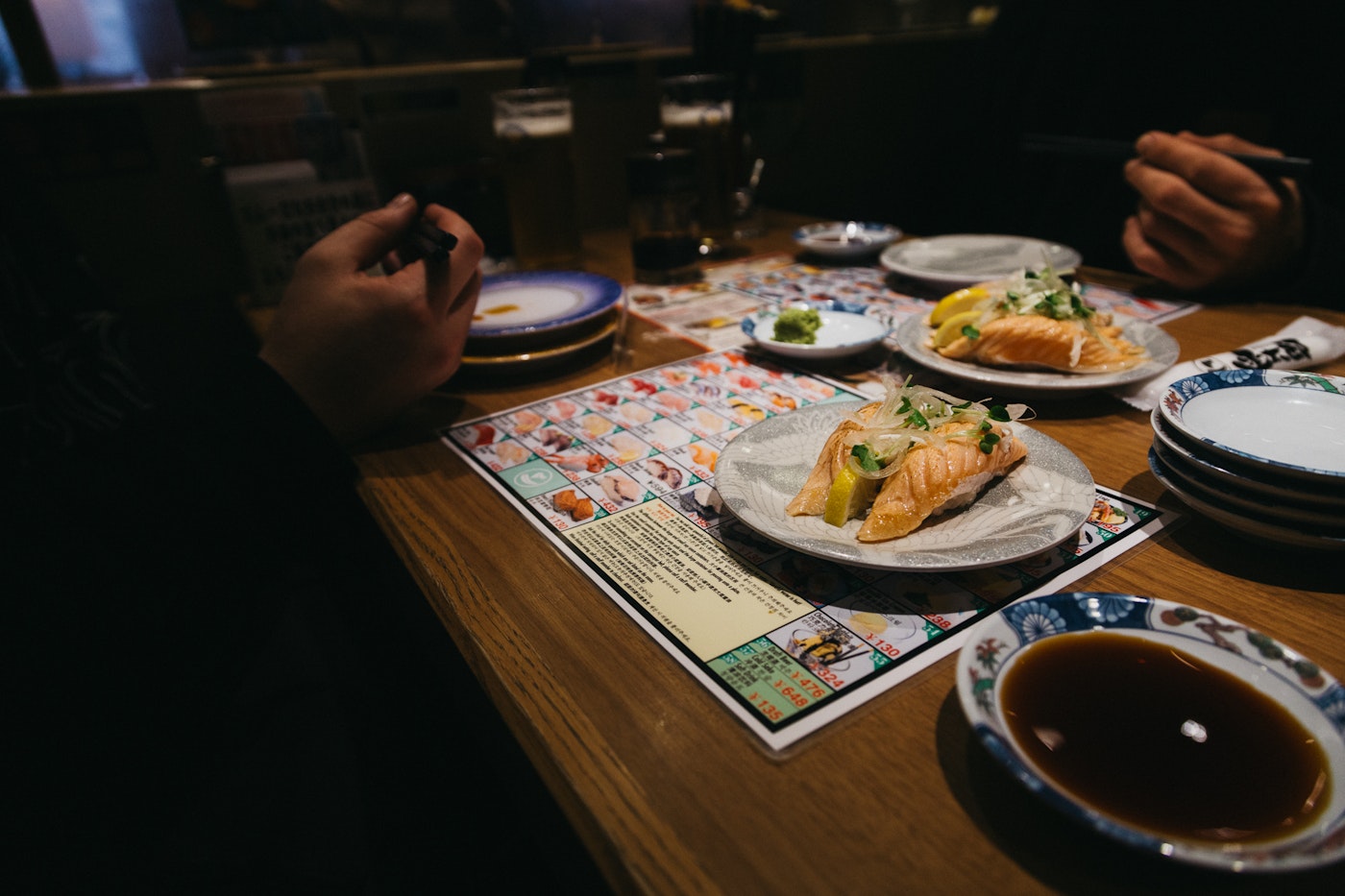
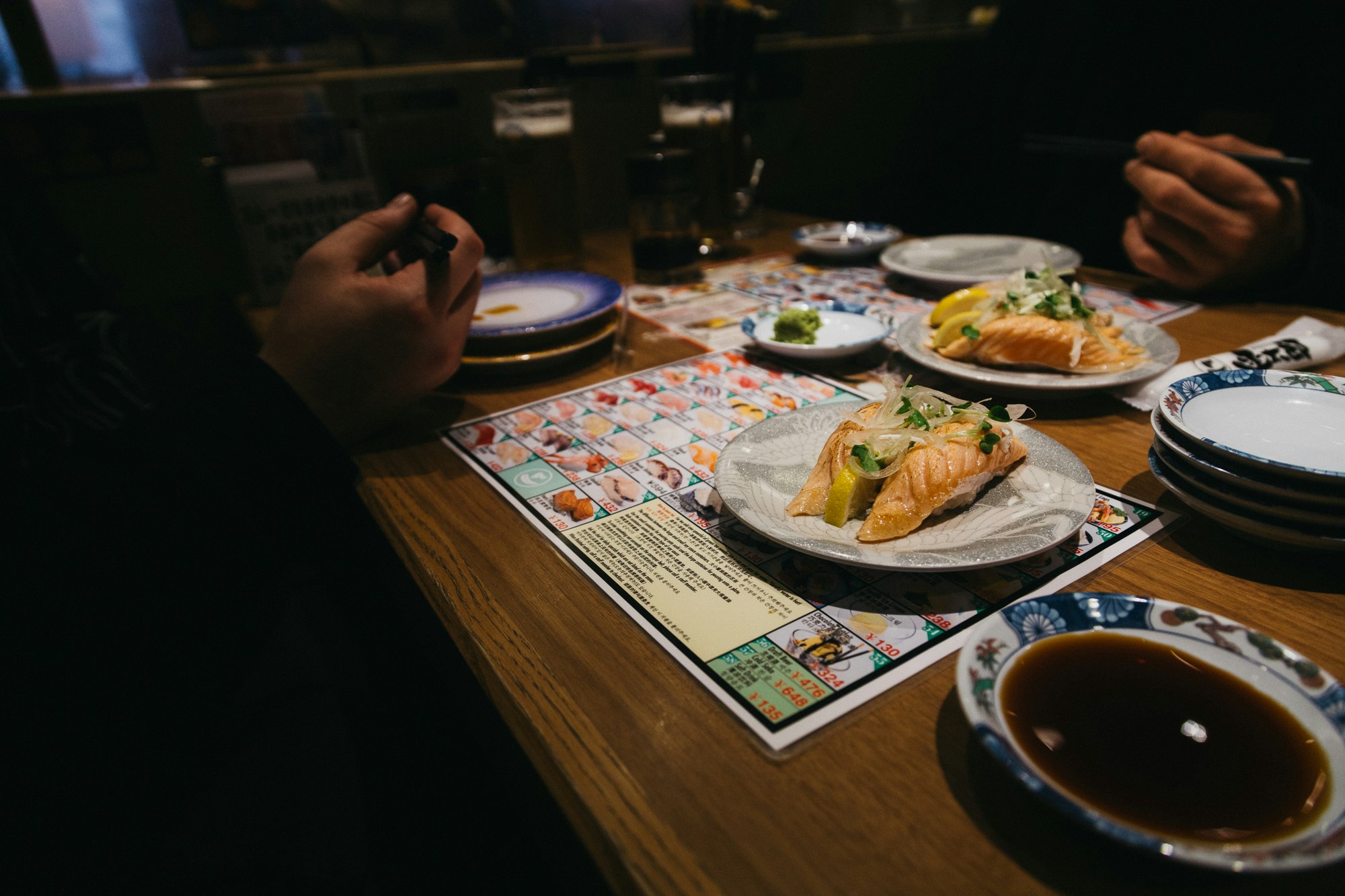
A bonus of skiing in Japan; the food | Photo: Ray Gadd
My journey to Hakuba Valley, Japan, had taken me through Tokyo’s Narita Airport and on to the capital city’s bustling central train station. Once there, I boarded the Shinkansen—a sleek, ultra-modern bullet train that whisks travelers through the countryside at speeds approaching 200 miles per hour. Although the excitement surrounding my first trip to the ‘Land of the Rising Sun’ had been bubbling inside me for months, the soft hum of the aerodynamic missile I was riding, coupled with the rapid emergence of the serene winter snowscape, provided me with a much-appreciated sense of calm.
I reclined into comfort as I watched the controlled chaos of the Japanese metropolis quickly fade into the distance. The mountains began to come into view but were quickly eclipsed by a wall of moisture-laden clouds that laid a fresh carpet of white gold across the narrow island nation—a standard state of affairs for one of the world’s snowiest locales. With just under an hour remaining on my 90-minute, high-speed train ride, it was the perfect time to dive into a little treat I picked up before boarding. I opened the ekiben, a carefully prepared Japanese boxed lunch, and marveled at the detail in the preparation of the high-end grab-and-go meal.
There’s something uniquely satisfying about enjoying a perfectly portioned sushi and pickled vegetable meal while hurtling through the countryside at breakneck speeds. The juxtaposition was almost laughable: there I was, enjoying an ancient culinary tradition in the confines of a train that felt more like a spaceship.
And, in true Japanese fashion, it somehow all felt perfectly balanced. By the time we pulled into Nagano Station, I had finished my meal and was primed for the final leg of my journey. The hour-long bus ride from Nagano to Hakuba Valley went by quickly as I chatted with an older, lifelong local who shared an interesting tale.
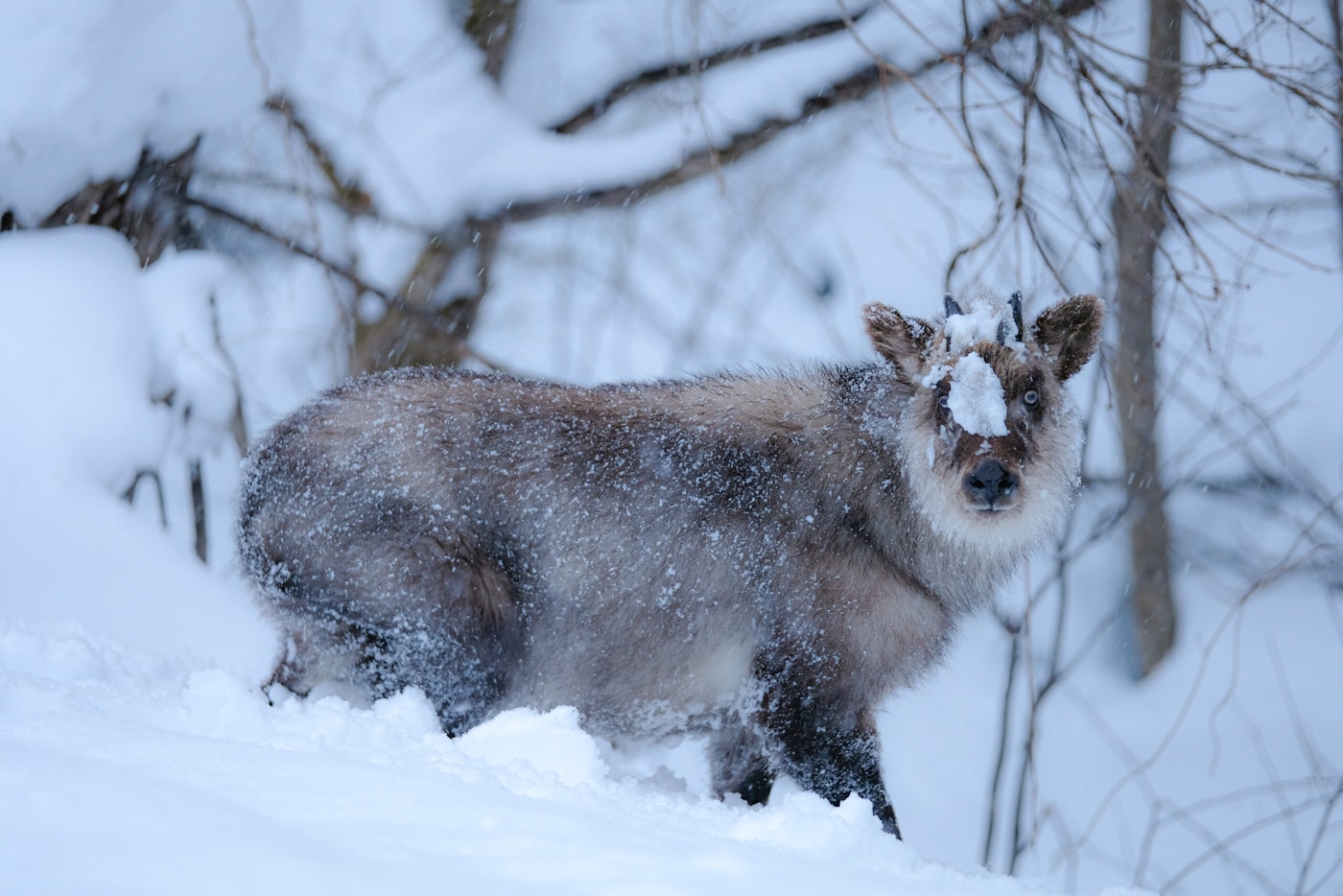
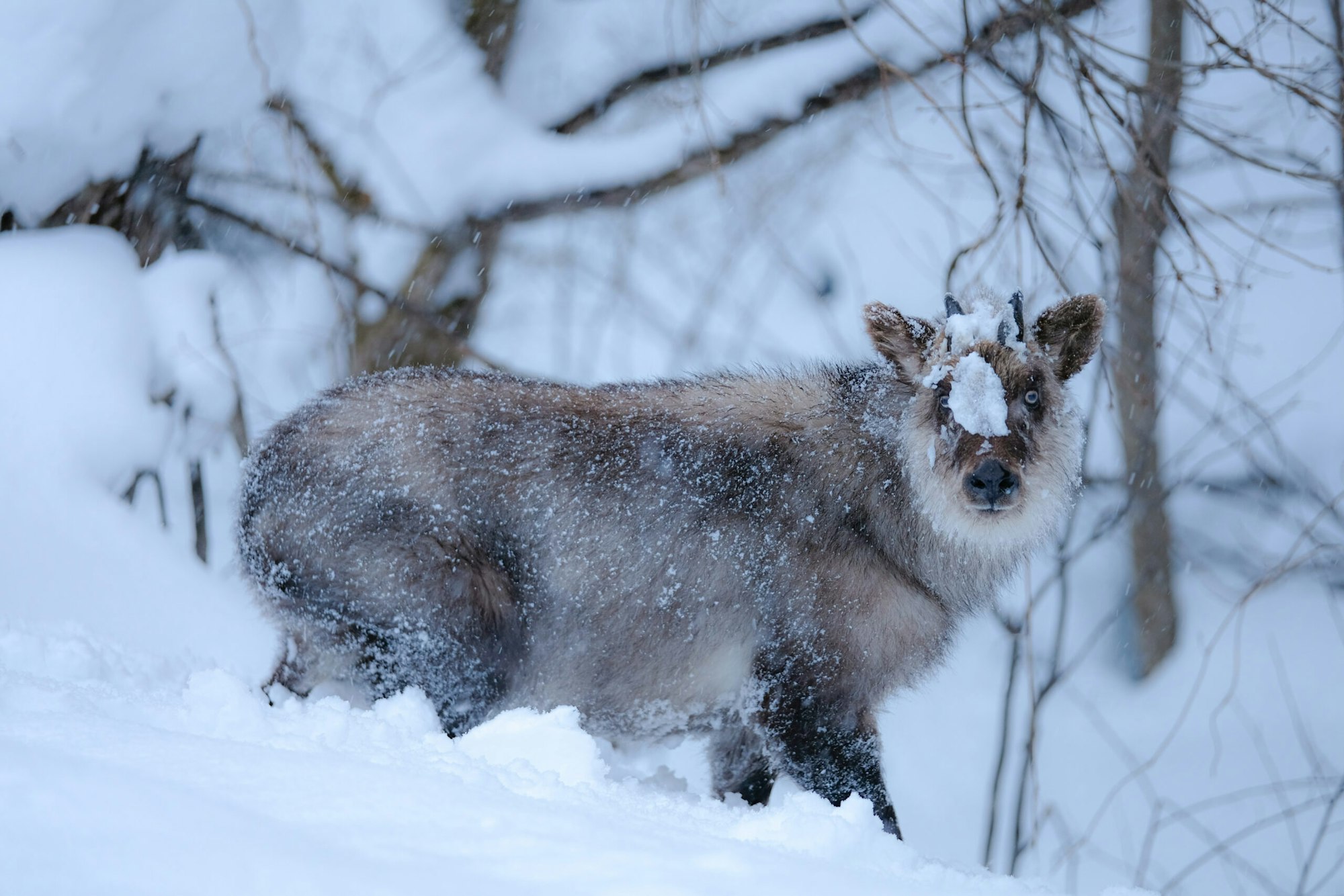
A stroke of good luck in the backcountry | Photo: Hiraya Nakata
Speaking softly through the gray Fu Manchu that adorned his weathered face, he leaned towards me and spoke of a quiet secret that the mountainous forests hide on the island of Honshu—Japan’s main island. He was speaking of the animal known as the kamoshika. Between his broken English and perfectly choreographed hand gestures, he painted the picture of a regal yet tranquil antelope-goat hybrid with a thick, grayish-brown fur coat and small rearward-curving horns. The most interesting part of his tale, however, was the folklore that surrounds its existence.
Known to nimbly navigate rocky cliff faces, I was told it’s a great compliment to be called kamoshika—a term bestowed upon the greatest Japanese skiers. He proclaimed that those who are able to spot one of these quiet, highly camouflaged creatures will experience good luck for years to come. As I weighed the validity of his legend and considered the implications of spotting this mythical entity, a brief window in the clouds unveiled a fleeting view of the dramatic high peaks of the jagged Japanese Alps. The history of this sacred mountain kingdom began to penetrate my being.

Although Hakuba Valley receives legendary amounts of snow, it would be a mistake to simply focus on the never-ending pow. The volume and type of terrain that can be accessed, especially when the visibility is clear, is nothing short of astounding. From large, open bowls to steep spines and fields of playful pillows, the options are limitless. The go-to, however—especially when gyoza-sized flakes are piling up—are the perfectly spaced birch and pine forests you might recognize from photos and videos plastered across social media.
On that first fateful ski day, in a forest much like the aforementioned, my partner emerged from a billowing contrail of cold smoke and raised his goggles, exposing a look of bewilderment. With a powerful gaze fixed over my shoulder, he slowly murmured, “What the hell is that?” I turned, and across a small gully, standing perfectly still amidst the trees, was the blurry outline of the legendary kamoshika. Mirage-like—its fur blended seamlessly with the trees and snow, its dark eyes trained on us, unblinking, as if it were sizing us up. My heart was pounding. Was this it? The animal that I’d half- convinced myself was nothing more than a tall tale told by an imaginative, elderly man—was it actually real? We didn’t move. We just stood there for what seemed like an eternity, staring at the gray apparition. Then, without provocation, it turned and disappeared into the woods, as quietly as it had appeared.
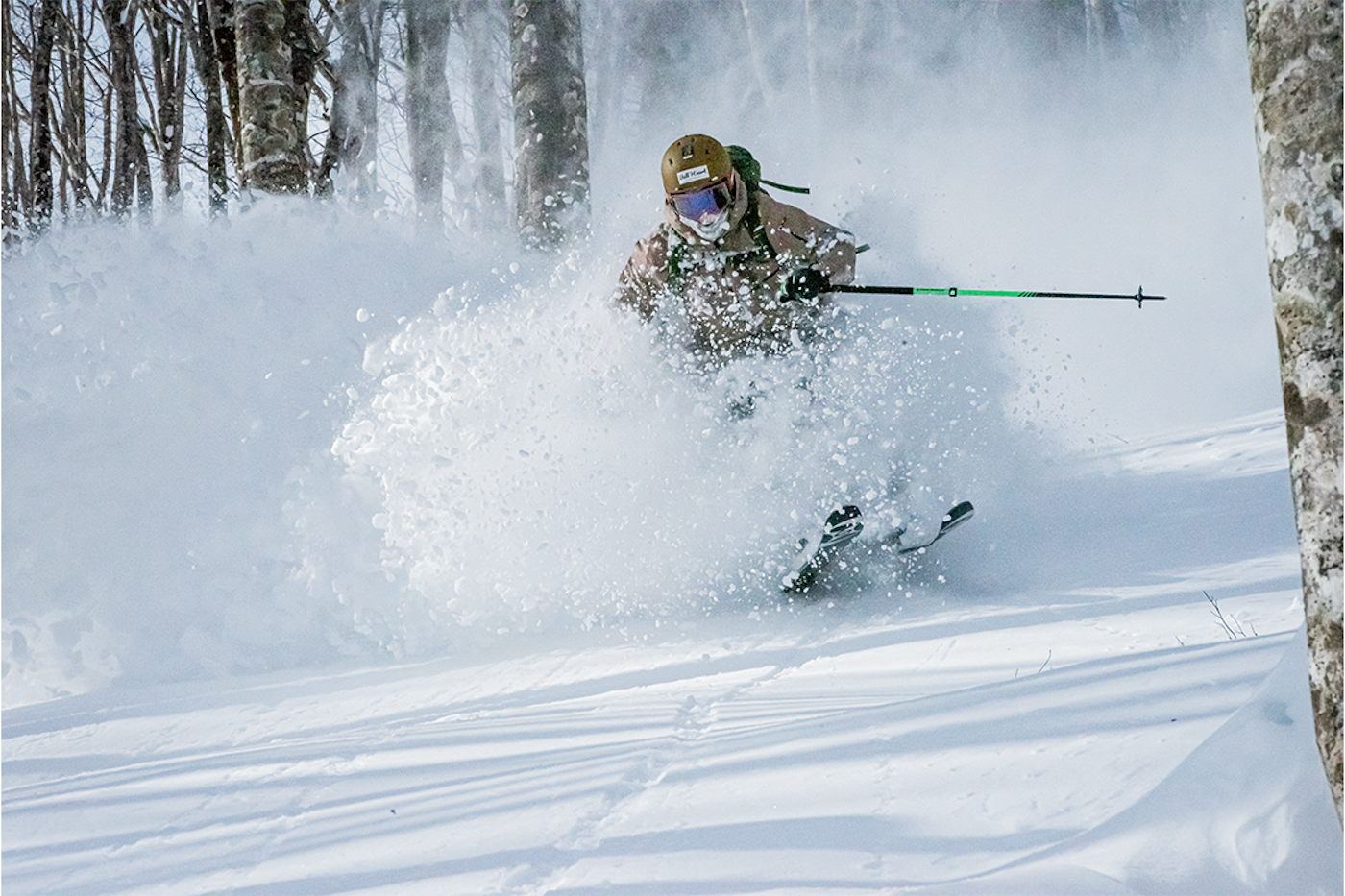
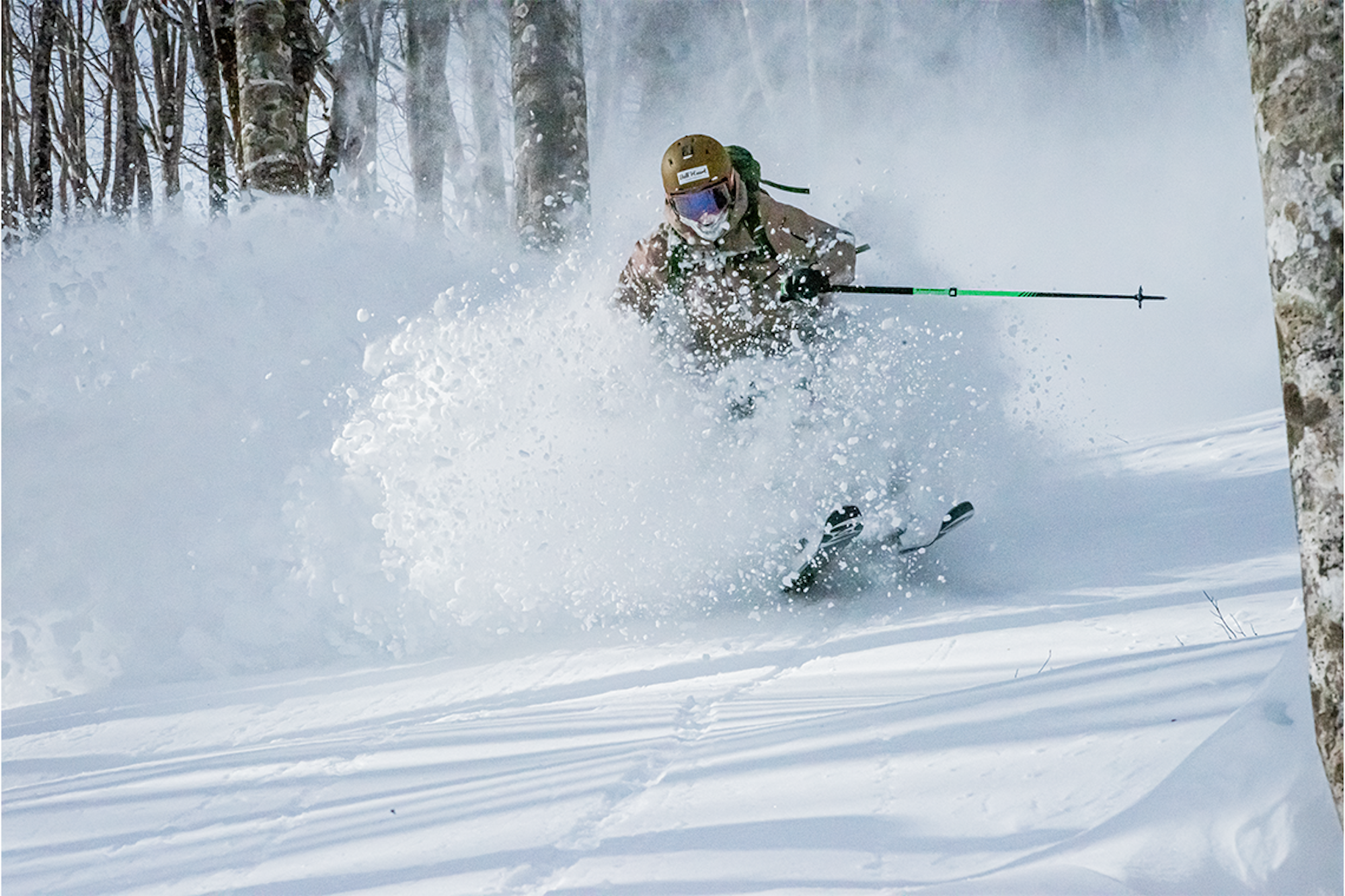
Skier: Yusuke Fukasawa | Photo: Hiraya Nakata
AFTER THE DAY’S remarkably deep skiing and questionable wildlife sighting, we were in need of rejuvenation. The best remedy was a soak in one of Japan’s sacred onsens. These natural hot springs are more than just a place to submerge tired muscles; they’re part of a centuries-old tradition rooted in Japanese culture—a ritual of purification and relaxation. As I shuffled through the entrance, steam permeated my skin and warmed me from within. The therapeutic process had begun. Perched upon a small stool, I performed the mandatory pre-soak bathing before sliding into the large pool. The mineral-rich hot water enveloped me and instantly, melted away the muscle aches.
There’s a reason the Japanese consider onsens to be healing, and it’s not just because of the minerals. It’s the stillness, the ritual and the solitude that make it sacred. In that serene steam, I felt connected to something deeper, tapping into an ancient practice that had been honed to perfection over generations. The misty haze that clung to the surface of the quiet oasis parted just long enough to reveal the aging face of the old man I spoke with on the bus. He slowly pressed his palms together under his chin and lowered his head into a bow. Before I had a chance to react, the fog thickened, and the man’s silhouette melted into the mist. My friend turned to me, his face pale, as if he’d just seen a ghost.
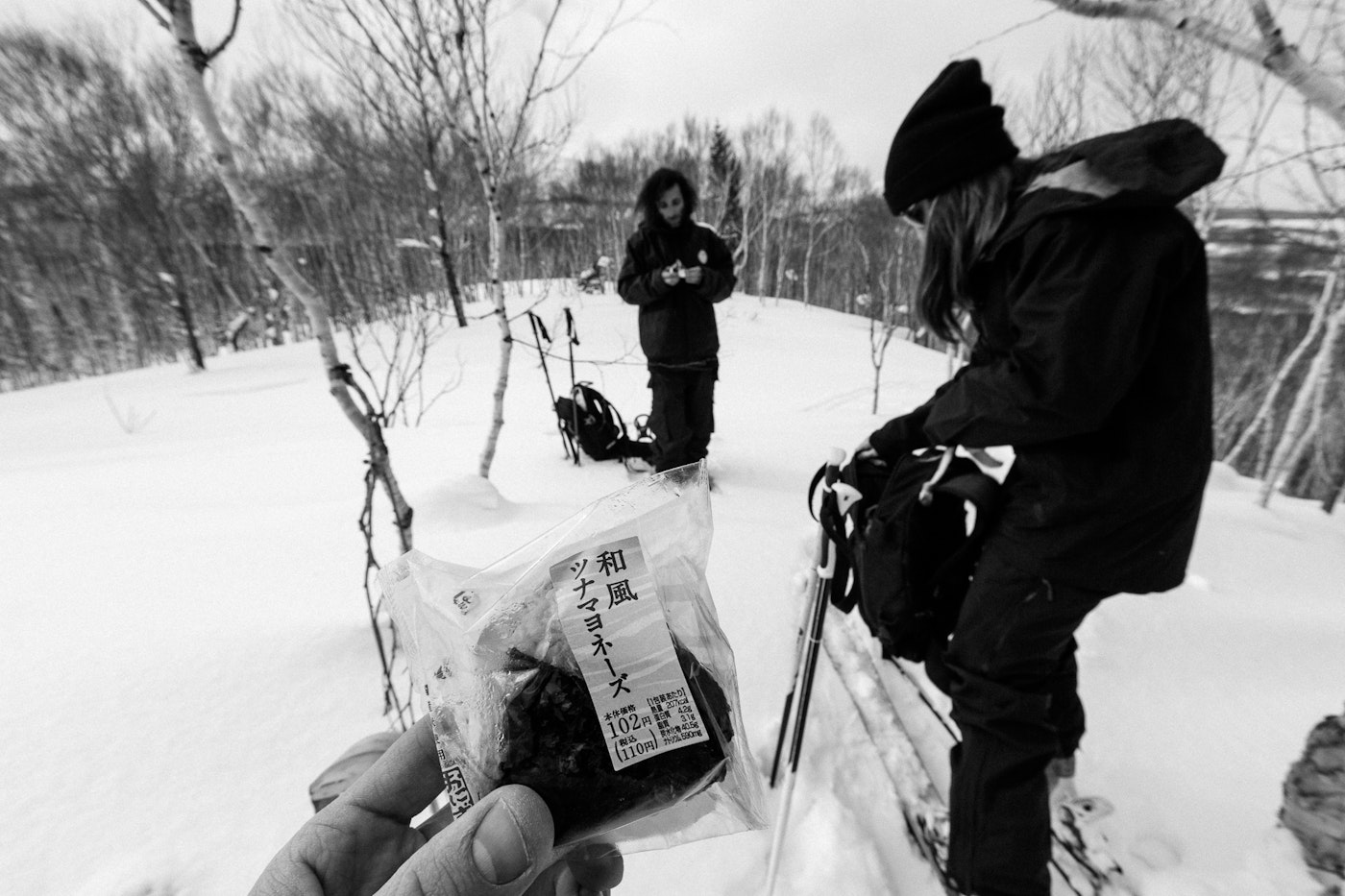
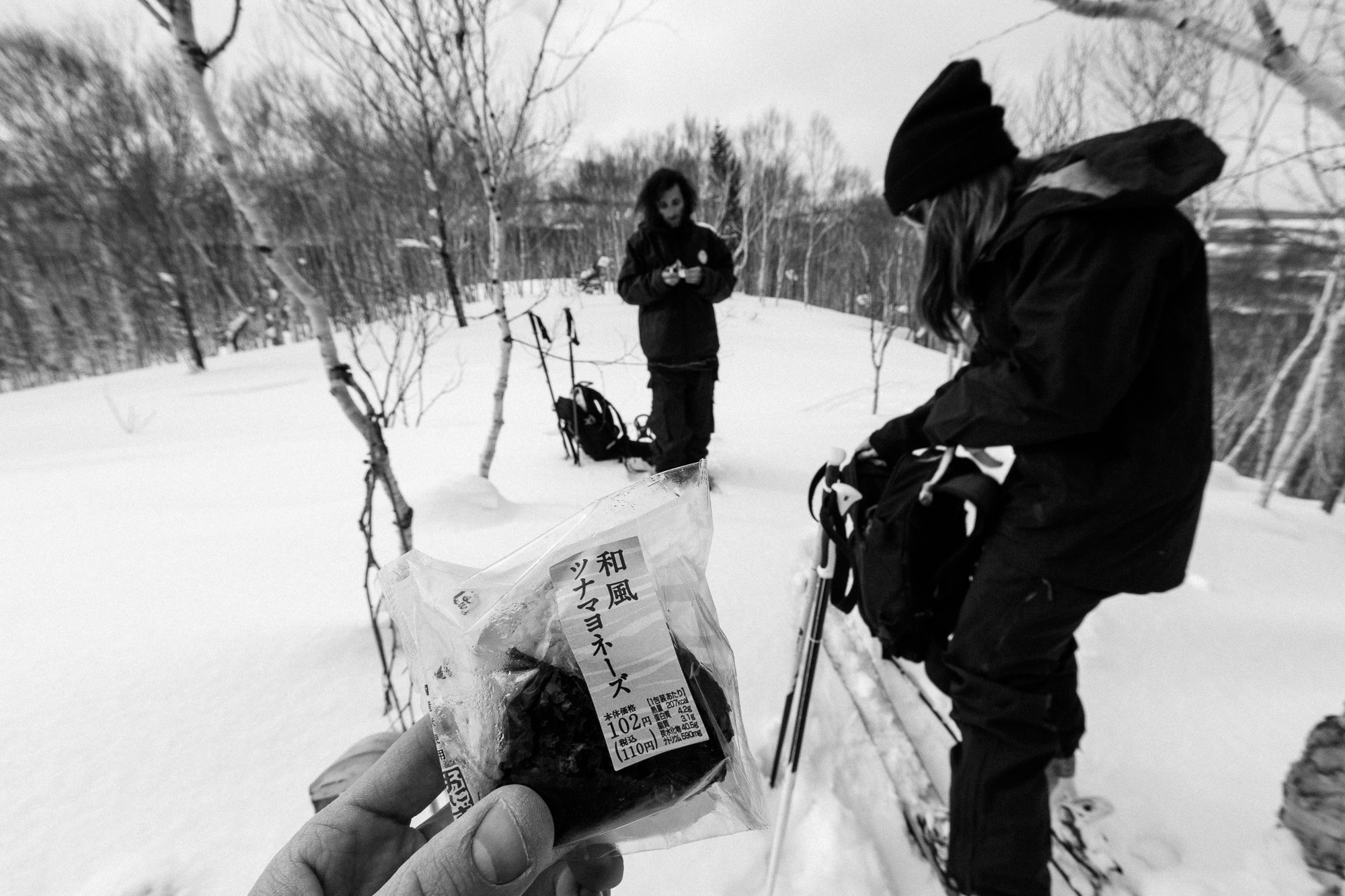
Photo: Ray Gadd
The next morning, I awoke early and was pleasantly surprised to see the sun bursting over the jagged ridge of the Japanese Alps. With Hakuba Valley’s bounty of high alpine terrain on full display, it was the perfect opportunity to test the terrain above the treeline. We made our way to the top of a wide-open bowl that sat within gazing distance of a dozen-plus serrated, Alaska-esque spine lines. The views were surreal. Eventually, we picked our jaws up off the glistening snow. For the morning’s objective, we chose to descend a prominent ridgeline that led us to a west-facing cirque, laden with gentle ribs that naturally subdivided the terrain.
With a detailed plan in place, my partner and I leapfrogged our way down the seemingly endless expanse below. There were no trees in sight as we dove to the bottom of the crystalline sea. Turn after turn, I got mouthfuls of snow before surfacing for a breath of cold mountain air and then descending for another helping. We were happy to indulge in the all-you-can-eat breakfast buffet of Japanese blower pow. Finally, with our legs begging for a break, we headed to a small sushi and ramen restaurant to recharge.
We seated ourselves in a corner that provided a perfectly framed view of the morning’s first run, which, when I think back, stood out as the crown jewel of the entire trip. Our server quickly appeared, as if he had materialized out of thin air, and I immediately recognized the all-knowing look on his well-worn face. He turned to me and quietly said, “You have experienced the greatest of luck on the mountain today.” Unsure if this was a question or a statement, I respectfully responded, “Yes, we have. And thank you.”
At that moment, I realized the legend of the kamoshika had little to do with the existence of an animal; it was more about the connection between man and nature—a reminder that sometimes the greatest rewards come when you least expect them. Hakuba Valley gave me more than just legendary skiing, efficient transportation and soothing hot springs. It had bestowed upon me a journey that blended modern convenience with deep cultural tradition—a trip that left me both exhilarated and at peace. Perhaps it was good planning, but more likely it was a touch of luck delivered by the ‘GrayGhost.’
Travel Tips
HAKUBA VALLEY RESORTS
TOTAL NUMBER OF RESORTS: 10
TOTAL CHAIRLIFTS: 126
SKIABLE ACRES: 2,325
AVERAGE ANNUAL SNOWFALL: 32-42 ft
HOW TO GET THERE
Fly to Tokyo
Tokyo has two international airports—Narita (NRT) and Haneda (HND). Narita is located just under 40 miles from Tokyo’s city center, while Haneda is just over 10 miles away.
Board the Bullet Train to Nagano
From HND, hop on the Tokyo Monorail to Hamamatsu-cho and transfer to the JR Keihin- Tohoku or JR Yamanote Lines to the Tokyo Station (Travel Time: 30 minutes). Get off on the Yaesu (East) side of the station and follow bilingual signs to the Shinkansen (bullet train) ticket gates. Tickets can be purchased up to 38 days in advance (Travel Time: 90 minutes).
WHERE TO STAY
Hakuba Mominoki Hotel
A simple yet sophisticated accommodation with an affordable price tag, the Mominoki Hotel offers a series of multi-night packages (which include breakfast) and is centrally located to many of Hakuba’s resorts. The closest, Happo One Ski Resort, is less than a five minute walk. The on-site “Beauty Bath” onsen has one of the highest pH levels in Hakuba, making your pow day recovery a cinch.
evo Hotel Hakuba
New for the 2024-25 season, evo’s Hotel Hakuba takes a modern approach to hotel design. With a focus on community spaces for like-minded adventurers, the new accommodation includes a soothing onsen, continental breakfast, bar, lounge and resort shuttles.
Hoshino Resorts KAI Alps
If you’re looking for a 4-star experience, the KAI Alps retreat awaits your visit. From Tsukemono pickling workshops to breathtaking onsen access and traditional Japanese hearth gatherings, KAI Alps offers a rural and genuine Japan experience. The hotel is about 30 minutes form the closest resort and offers daily free shuttles.
BEYOND THE RESORT
Explore the Nagano Region
Located just over an hour from Hakuba, the city of Nagano is a great place to spend an afternoon or overnight during your trip. Spend the day visiting the Snow Monkey Park to marvel at the little creatures as they lounge in the natural onsens. Better yet, treat yourself to a luxurious spa day and let your pow legs recover at one of the many natural Onsen resorts. At night, be sure to visit the Matsumoto Castle to catch the stunning light shows or feast your way through the narrow city streets with a guided food tour.
Backcountry Skiing
If the solace of a backcountry excursion calls your name, be sure to check out the many backcountry guiding services in Hakuba Valley. Spend the day in the untracked powder fields surrounding the valley where you’ll acquire a new definition for the word ‘deep.’
PRO TIPS ON EXPERIENCING HAKUBA
Epic Pass, Epic Local Pass and Epic Australia passes include a complimentary 5-consecutive-day Hakuba Valley All Mountain Lift Pass that can be picked up at a designated ticket window of any of the Hakuba Valley snow resorts.
January and February are typically the resorts’ busiest months of the year, so planning a trip in March may help you experience the skiing, scenery and authentic Japanese culture with fewer people in your way.
This story originally appeared in FREESKIER Magazine Volume 27 Issue 2. Click here to subscribe to FREESKIER and have print copies (yes, real print magazines!) delivered right to your door.

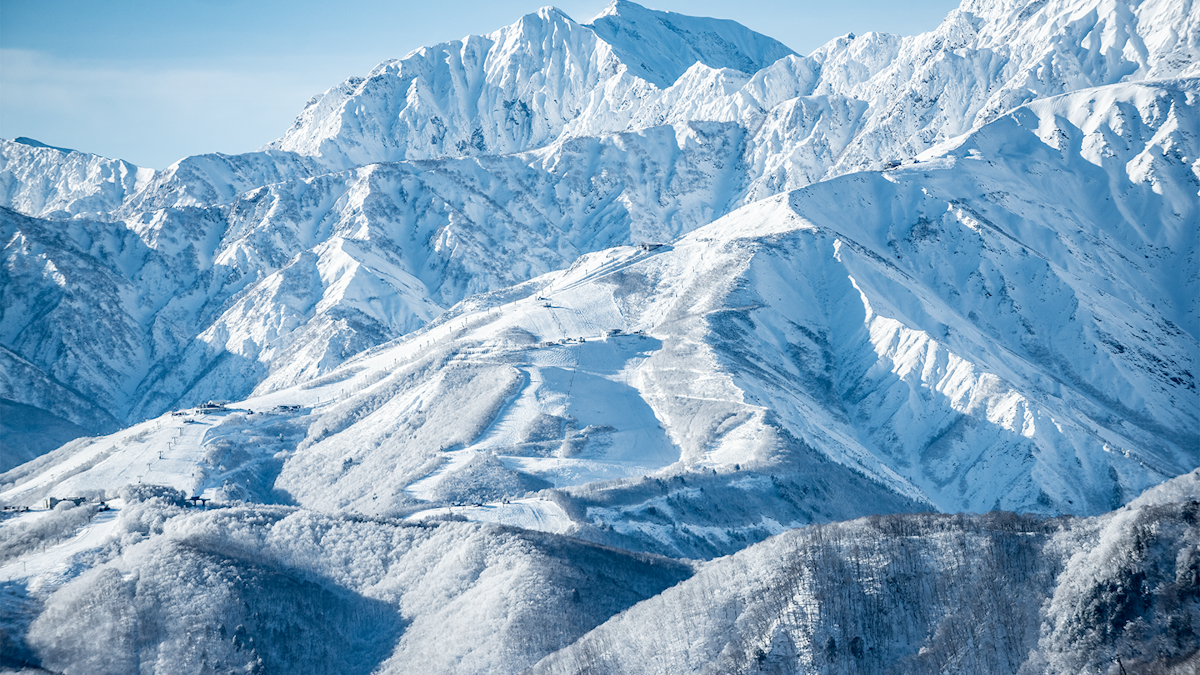
![[GIVEAWAY] Win a Head-to-Toe Ski Setup from IFSA](https://www.datocms-assets.com/163516/1765920344-ifsa.jpg?w=200&h=200&fit=crop)
![[GIVEAWAY] Win a Legendary Ski Trip with Icelantic's Road to the Rocks](https://www.datocms-assets.com/163516/1765233064-r2r26_freeskier_leaderboard1.jpg?w=200&h=200&fit=crop)
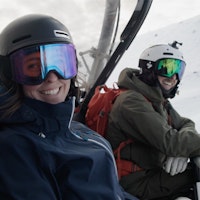
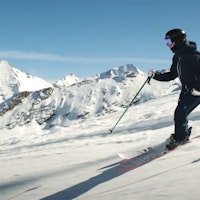
![[GIVEAWAY] Win a Legendary Ski Trip with Icelantic's Road to the Rocks](https://www.datocms-assets.com/163516/1765233064-r2r26_freeskier_leaderboard1.jpg?auto=format&w=400&h=300&fit=crop&crop=faces,entropy)
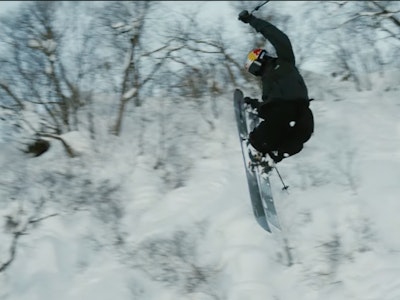

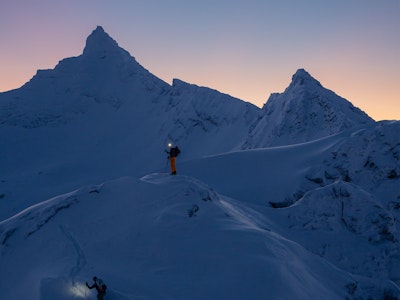
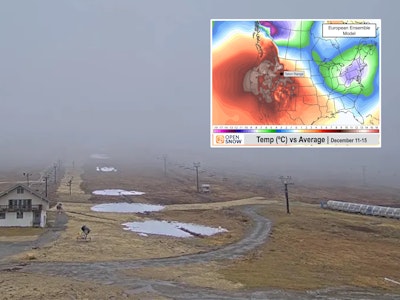
![[GIVEAWAY] Win a Head-to-Toe Ski Setup from IFSA](https://www.datocms-assets.com/163516/1765920344-ifsa.jpg?auto=format&w=400&h=300&fit=crop&crop=faces,entropy)
